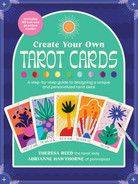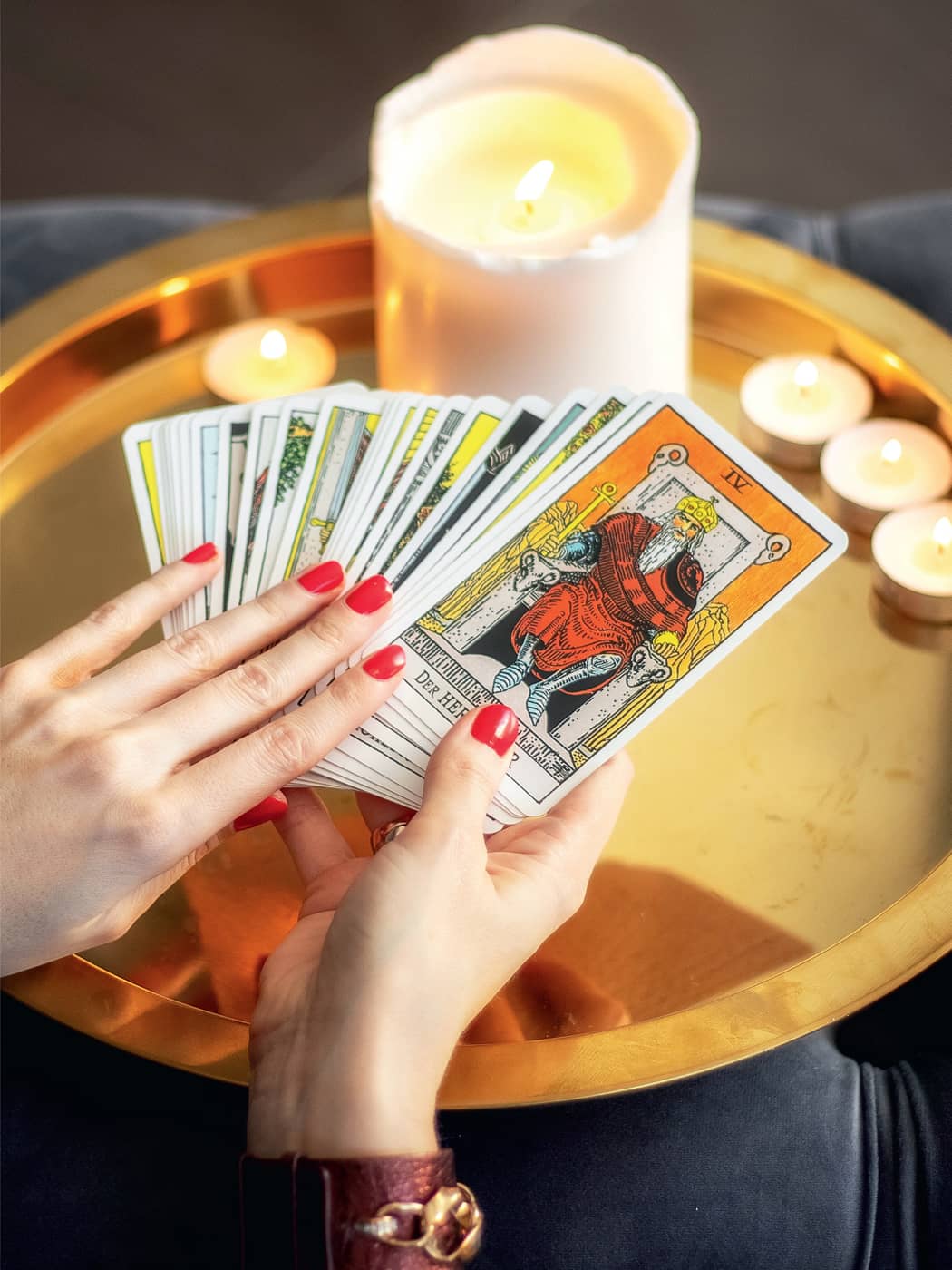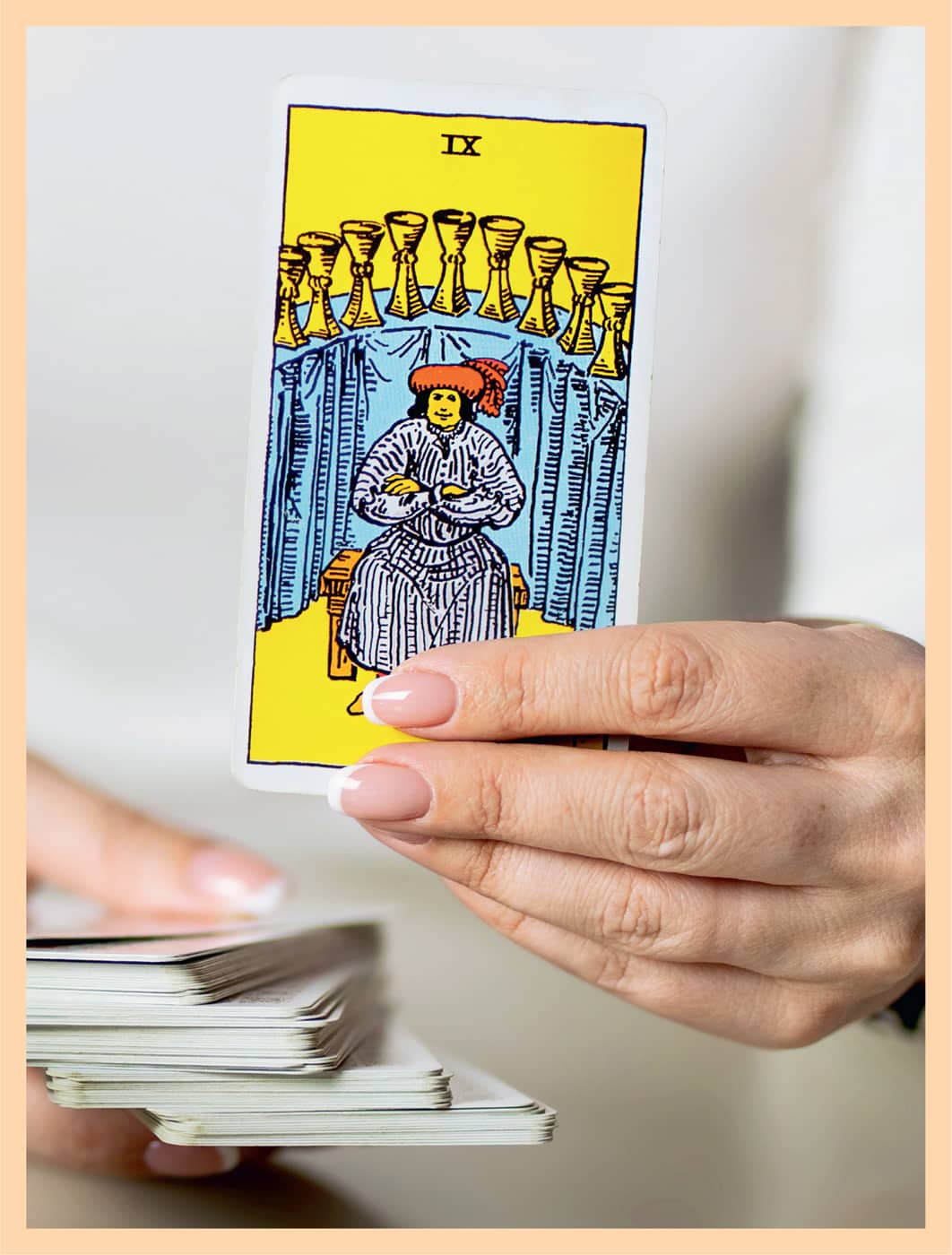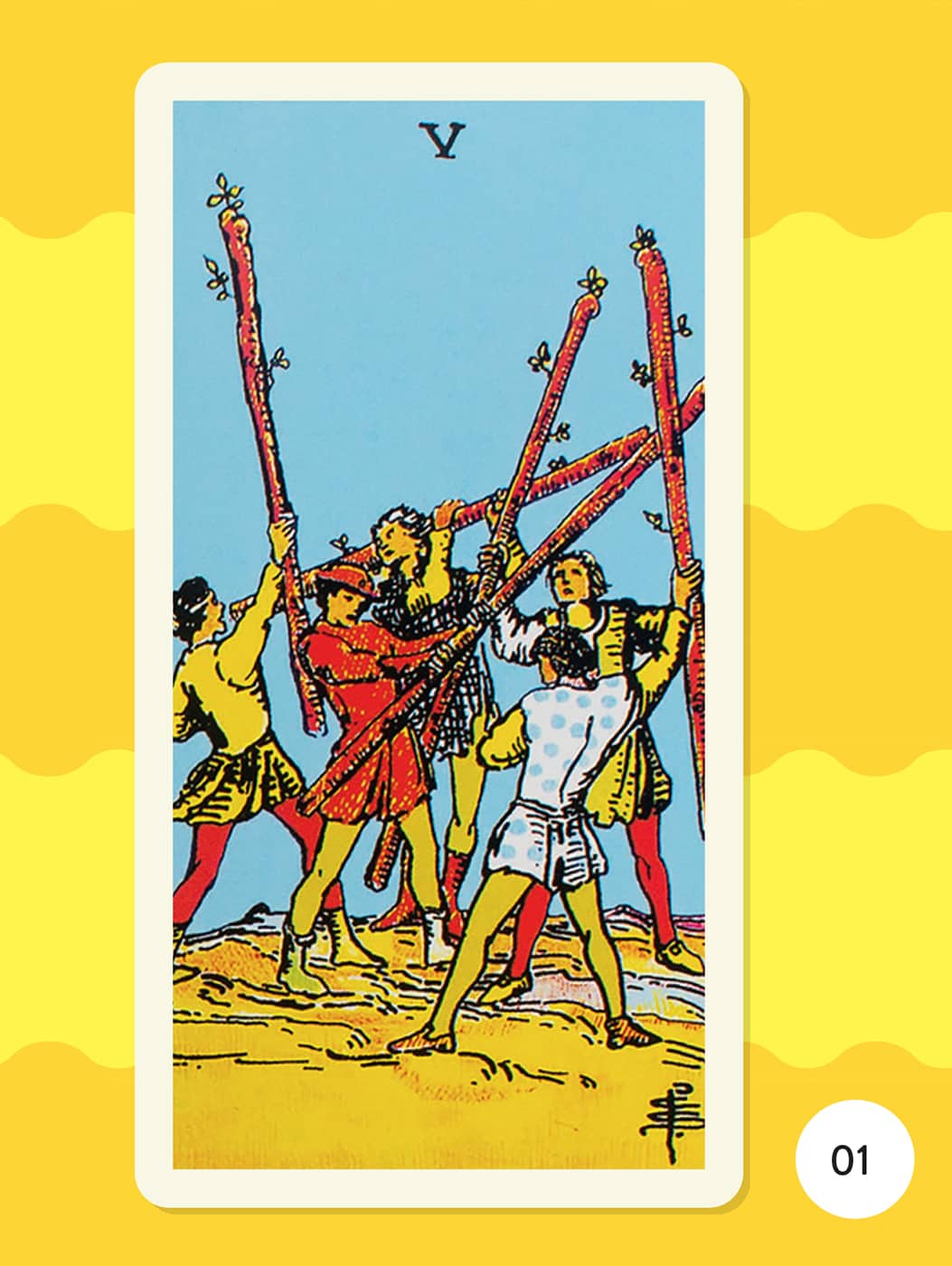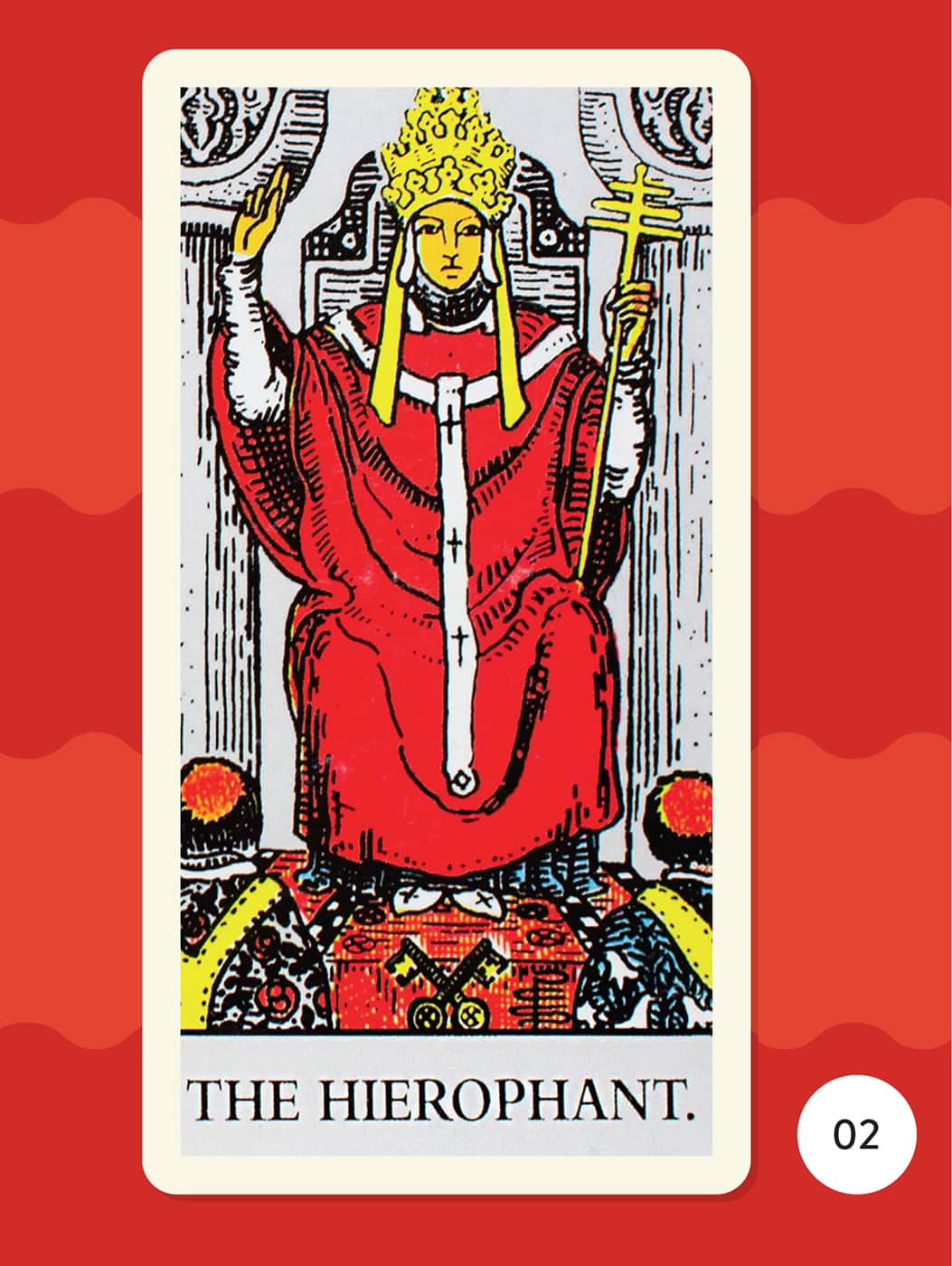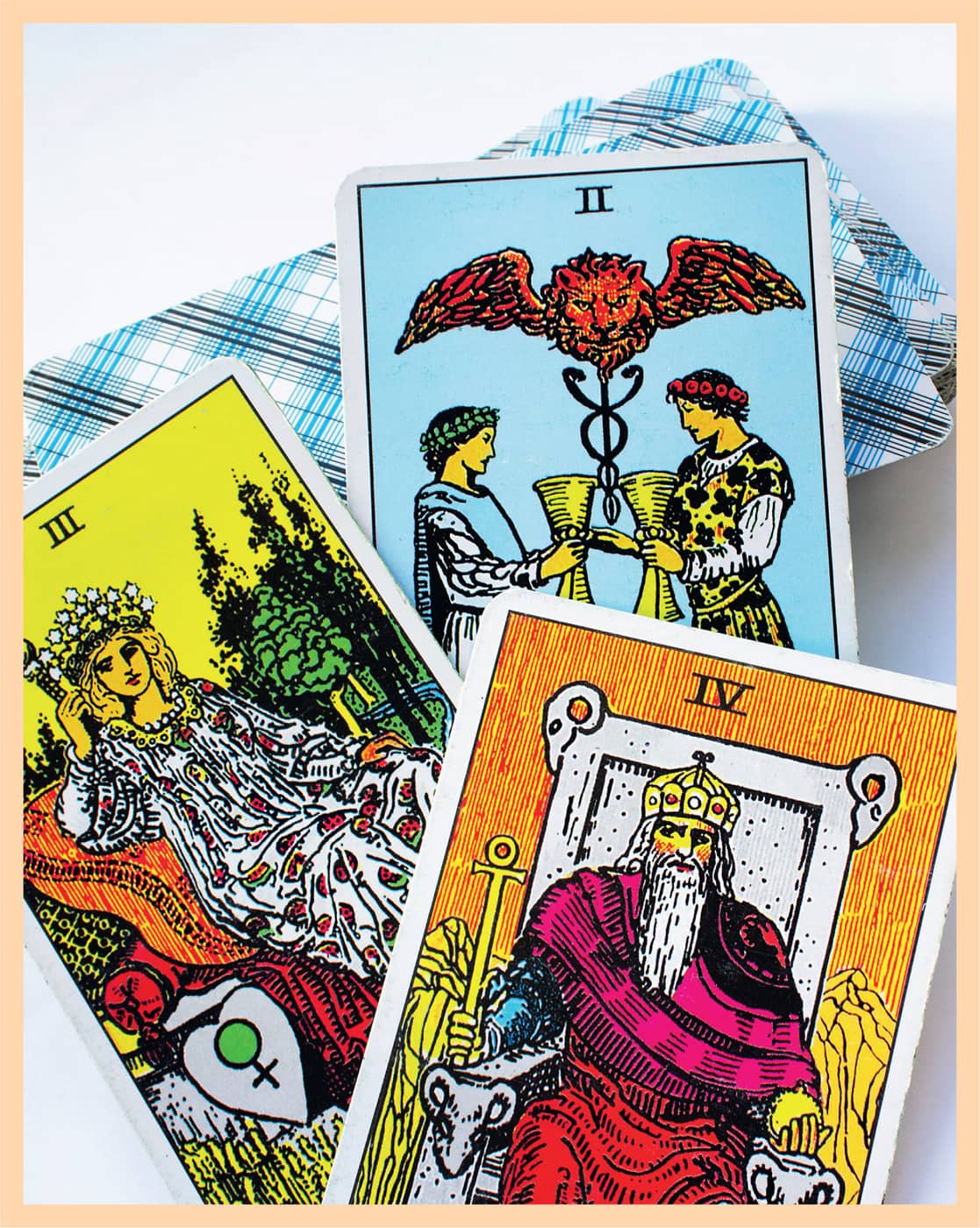HOW TO DO A TAROT READING

You might be wondering how tarot works . . . specifically, how to do a reading. It’s actually quite simple! You think of a question, shuffle the cards, pull one (or a series of cards), turn them over, and begin interpreting. That’s it.
However, although the process isn’t complicated, there are a few things to know about delivering or receiving a helpful, empowering tarot reading. First, it begins with a calm, open mind. If you’re coming to the tarot table in a panic or with a closed-off attitude, you won’t get much out of your reading. Chances are, you’ll see what you want, what you fear, or nothing at all. A chill, receptive mindset sets the perfect stage for a great reading.
Next, you’ll need to formulate a strong question. Many people assume that tarot will see the future with all the details laid out in a nice, clean storyboard. While tarot cards can predict likely outcomes, the future is rarely set in stone. You do have a say in how things unfold, however. Tarot is not a passive act—and neither is your life. Your choices can turn a situation around . . . or tank it. Therefore, you’ll want to avoid questions that create a fatalistic approach to your future.
For example, a “will this happen” query may give information about what’s ahead, but it’s not a guarantee. There are plenty of factors that can alter the outcome, including your inaction as you sit around waiting for something to happen.
Instead, a better way to frame a question will go something like this: “What do I need to know about . . . ?” or “How can I . . . ?” When you formulate your questions in this manner, the cards will offer up guidance more aligned with taking control of the wheel rather than being the passenger. After all, this is your journey. Wouldn’t you rather know the best way to reach your destination and how to avoid the potholes along the way?
PUTTING IT INTO PRACTICE
If you want to know the outcome of a situation at work, instead of asking, “Will I get the promotion?”, try: “What do I need to do to receive a promotion?” The second question can give you helpful information about your circumstances and advice for stacking the odds in your favor. This creates a proactive approach to your life, which allows for conscious living.
So, let’s say you have your question. Let’s use the one in our example. Before you begin, take a minute to wash your hands. This will prevent greasy fingerprints and other debris from wrecking your deck.
Once you’ve cleaned your hands, the next step is to shuffle your cards thoroughly while thinking of your question. Shuffling is like a miniature ritual. As you sit quietly, jumbling the cards, you might notice that your mind begins to settle down. Breathe deeply and keep the question on your mind as clearly as you can. Do not fixate on the outcome. Instead, remain as neutral as possible as you continue rearranging the cards. Then, when you feel “ready,” put the deck facedown in front of you.
How do you know if it’s ready?
You simply know. The cards “feel” like they want to speak to you. Or perhaps you’re tired of shuffling them. That boredom can be a sign you’ve done enough and that you are prepared to throw down and begin interpreting.
With your left hand, divide the deck into three piles. Why the left hand? Frankly, it’s an old superstition that goes something like this: Your left hand is closer to your heart. Therefore, the reading will come from the heart. Silly? Perhaps. But sometimes, those old superstitions have a bit of truth to them. I’ve cut my cards this way since I first had a deck in my hands, and it’s always worked out. (I’m left-handed, so maybe there is something to that too.) Feel free to use the other if you don’t want to or can’t use your left hand. Now, put the deck back together any way you wish.
LET’S READ!
The cards have been shuffled, cut, and put back together. So, take a deep breath—and let’s start interpreting!
You may decide to pull one card or a series of cards, which is called a “spread.” One card can deliver a lot of information. Often, it’s all you need. However, I’ll suggest a few good spreads in a minute.
There are two methods for choosing cards:
- You can take the first card from the top of the deck.
- Or you can fan the cards out facedown and let your intuition determine which one(s) to pull.
Both methods work well. Ultimately, you’ll need to determine which feels right.
Once you’ve chosen the card(s), turn them over and lay them in front of you. Take a minute to scan the images. What are your initial thoughts? Is there a particular symbol in the card that draws you in? How do the colors make you feel? What might the figures say if you had a conversation with them? If you chose more than one card, what story is unfolding, and how are the cards interacting with each other?
Let your intuition begin guiding you to find your interpretation. Of course, you’ll want to keep your question in mind as you do. After all, if you pull the Seven of Cups for a romantic question, it will have a different meaning than a business query. The basic meaning of the card may still hold true, but your sixth sense will find interpretations that make sense for the question.
Using our question, “What do I need to do to receive a promotion?”, let’s try out a few different tarot cards to see what interpretations we might find.
01. Five of Wands
This is a card of competition. There may be other people gunning for this same promotion. If you want to win the coveted spot, you must be willing to give it your all. It’s not enough to throw your hat in the ring—you must be ready to fight. A strong effort will allow you to stand out in the crowd. Keep your hustle mighty and you could win big.
02. The Hierophant
First of all, you must be willing to play by the rules. The person in charge is a stickler for policies. This means you don’t get to be the rebel; you must fall in line and show that you understand how to operate in this environment. There may be specific rules in place for this particular position. Secondly, you might need to work closely with your boss or mentor to learn the ropes. Be a willing pupil, and you’ll be ready to take the reins with confidence. Better yet, your boss will be impressed with your willingness to learn.
03. Page of Cups reversed
You may not be ready for what this job entails. Before you dive in, gather more information. For example, will the hours be longer, and if so, will they cut into your precious family time? What additional duties may come with this promotion? More importantly, why do you want this promotion? Is this aligned with your heart or your pocketbook? Look deeply into the situation before you say yes. You might find this isn’t what you thought it would be.
See how different those interpretations are? Now consider for a moment if the question was about finding love. These meanings will change dramatically even while retaining the traditional associations. The Five of Wands could mean putting yourself back into the game; the Hierophant could suggest a matchmaker; and the Page of Cups reversed may warn you not to be emotionally impulsive.
As always, you’ll want to examine the card, keep the question in mind, and go from there. But, above all, trust your intuition. It knows what’s up and will help you find the proper guidance.
SPREADS
When you choose more than one card, it’s called a “spread” or “layout.” While one-card readings offer a wealth of information, additional cards allow for a deeper story.
Spreads may have defined positions—or not. If you’re working with the latter, your intuition will be the key in determining what the cards are trying to say. On the other hand, a layout with particular positions offers a guideline for the reader.
For example, let’s say you choose The Empress, Two of Cups, and Nine of Cups. If there are no positions defined, you can scan the cards and see how the figures interact and perhaps notice patterns such as the presence of two from the Cups suit. It’s pretty safe to say this reading is showing a favorable outcome for romance. Perhaps you’re about to meet someone new, and it could be precisely the type of relationship you desire.
Now, let’s change this up. If you’re doing a spread like the Body, Mind, Spirit, the interpretation has a structure. For example, The Empress for the Body might indicate a healthy, well-cared-for physique. The Two of Cups for Mind would show balance and healing, while the Nine of Cups for Spirit might suggest a happy meditation practice.
You’ll need to be clear on whether you want to use a tarot spread or not before you begin shuffling. Here are a few suggested spreads you might try.
Body, Mind, Spirit
This is the perfect spread when you need to check in and see how you’re doing. Use this at the beginning of your day or week, or anytime you need to get in touch with your well-being.
Shuffle and cut as usual. Then fan the cards out facedown and use your intuition to pull cards for each position.
Study the images. What clues are they giving you about your body, mind, and spirit? Is it time to level up your self-care or spiritual practices?
Always remember that if you don’t like the outcome, you can change course. Here’s a spread I use all the time for guidance:
Past, Present, Future
This simple tarot spread can help you see where you’ve been, where you are, and where you might be going next. You can use this when you want a glimpse into the future.
For this spread, you can choose to take the cards from the top of the deck or fan them out and choose consciously. Either way works fine.
Read the cards from left to right as if you are telling a story with a beginning, a middle, and an end.
Always remember that if you don’t like the outcome, you can change course. Here’s a spread I use all the time for guidance:
The Situation: What You Need to Know & Advice
The beauty of this layout is the second position—what you need to know. This may reveal something you’re not seeing, and that information can be beneficial. The advice position also offers up guidance, which puts you firmly in the driver’s seat.
Once again, follow the typical shuffle-and-cut routine. Choose the cards from the top of the pile. Turn them over one by one, interpreting as you go. Pay close attention to “what you need to know” before you consider the advice card. Together, they’ll give you useable wisdom—and it may not be what you expect.
With these three spreads and one-card pulls, you have everything you need for practical, accurate tarot readings.
Of course, there are many spreads you may want to try out, such as the famous Celtic Cross. I recommend testing out as many as possible. You might even want to try to create some of your own spreads. I’ve done this myself, but frankly, I always end up coming right back to the readings suggested in this book.
COMMON TAROT READING ISSUES—AND HOW TO TROUBLESHOOT
When you begin learning tarot, you may have a lot of questions about the process. However, you might be surprised to know many longtime readers also have some of the same concerns. Here are a few of the most frequently asked questions—and my advice.
Q: I’m worried the reading will be wrong. How can I be as accurate as possible?
A: Here’s the deal. You will be wrong at times, especially when you’re first starting out. That’s how you learn. One of the things I’ve discovered over the years is that the cards are usually right on, and problems with accuracy often center around misinterpretation. This is why I recommend recording your readings in a tarot journal. As you look back at botched readings, you’ll be able to see where you missed the mark. Your tarot journal will give you all the information you need to start seeing where you went wrong and what direction might have been better. And those butterflies you’re feeling? They never go away. That’s not a bad thing. It’s a sign you care enough to want to do a good job. I’ve been reading tarot for 40 years, and I’ve never lost that little twinge inside before I sit down to read.
Q: Do I need to learn the meanings? Can’t I just go with what I see in the cards?
A: Ultimately, you’ll want to find a balance between the two. A solid foundation of knowledge will give you something to work with, and that builds tarot confidence. But, of course, your intuition will have a say in how you interpret those cards. If you’re getting a gut feeling, go with it, even if it seems out of place. Often, those flashes of intuition turn out to be accurate—and it’s cool when you get a psychic hit! In time, you’ll rely on the books less and less, and your instincts will uncover new meanings and depth to the cards. The more you work with them, the more you’ll learn to trust your sixth sense.
Q: What do I do if I draw a blank?
A: This happens to every reader, even seasoned pros!
First, take a deep breath. Next, scan the images and see what catches your eye. Is there a symbol that seems to stand out? If so, use that as a jumping-off point. If you still aren’t getting anything, start describing the card. When you do this, the story will begin to unfold, and you’ll find your interpretation. This is a technique many readers use—and it always seems to work. Of course, there may be times when no information is coming through, no matter how hard you try. When that happens, write down the cards and leave them alone for a day. Then revisit the reading at a later time. You might find the answer was more apparent than you thought!
Q: What does it mean if I get all reversals?
A: If your reading consists of nothing but reversed cards, it is a sign that something is blocked and you may need to look within . . . or give it time to manifest.
Q: My prediction didn’t come true. What am I doing wrong?
A: Often when a reading doesn’t work out, it’s due to misinterpretation. The cards can have different meanings, and if you review them later, you may see where you might have interpreted them differently. Keep in mind that no one is infallible and not every situation is clear. Sometimes you’re just not meant to know.
Q: Are there any questions I shouldn’t ask?
A: Trying to pry into other people’s lives is a no-no. Tarot is not for spying. Asking about situations that are none of your business? Nope. Don’t do that. It’s also unrealistic to ask the cards how someone feels about you. They aren’t a mind-reading tool. Lastly, you never want to ask questions that should be directed toward your doctor, lawyer, or therapist. Tarot is never a substitute for professional help.
Q: When shouldn’t I ask a question?
A: If you’re overly invested in the outcome, feeling freaked out, or impaired in any way, you’ll want to leave the cards alone. Your state of mind is essential. The best readings happen when you’re calm, clearheaded, and sober.
Q: What if I don’t like the outcome?
A: If you do not like the story the cards are showing, you can always pick a clarifying card for guidance. This may add additional insights or offer a detour. That being said, do not keep pulling cards just to get the outcome you desire. Life doesn’t always go the way you want . . . and neither does tarot.
